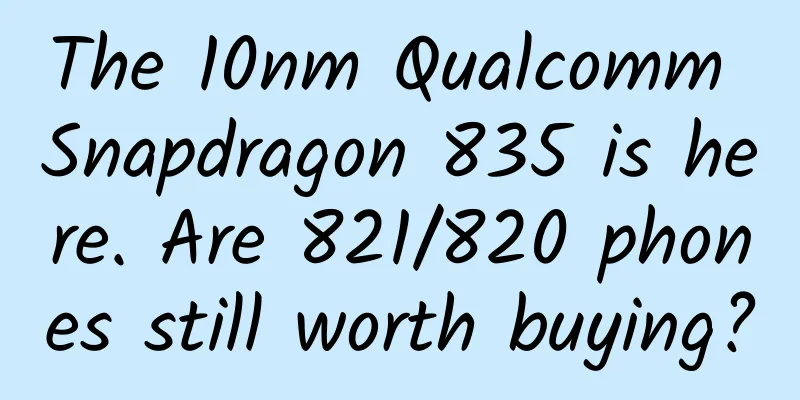The 10nm Qualcomm Snapdragon 835 is here. Are 821/820 phones still worth buying?

|
Winter is here, spring is not far away, and the new flagship phone is getting closer. I am so excited... This is not only the mood of our friends, but also the psychological portrayal of SoC manufacturers. Qualcomm has suddenly announced the 2017 flagship chip Snapdragon 835. As the successor of Snapdragon 820/821, it not only gives us new expectations for the performance of next year's flagship phone, but also makes us wonder, in addition to setting a new high in running points, what else can be more exciting? Advanced process is more important than the number of cores Last year, Snapdragon 820 was also released in November, which was almost a year away from Snapdragon 835. However, the situation of Snapdragon 835 is much better than that of 820 last year, which was responsible for the task of "cooling down" Qualcomm. Therefore, when Qualcomm announced Snapdragon 820, it poured out all the detailed parameters such as its architecture, main frequency, GPU, etc., but it did not reveal too much information about Snapdragon 835 this time. It mainly tells us one thing - it will be manufactured using Samsung's 10nm process technology. Interestingly, just one month before Qualcomm announced the news, Samsung announced that its 10nm process chip technology had achieved mass production. The two companies announced the news one after the other, as if they had discussed it. The biggest blow was probably to another chip foundry, TSMC. Not only did it once again hand over the title of "the first chip manufacturer to achieve mass production of 10nm process technology" to Samsung, but it also lost the rumored large order of Qualcomm Snapdragon 835. TSMC has always been competing with Samsung in semiconductor manufacturing technology. After being defeated by Samsung in the mass production progress of 14/16nm FinFET process, TSMC tried its best to lead Samsung in 10nm or even 7nm process. Unfortunately, just like the previous 16nm FinFET process, the news was constantly released before the official mass production, but the actual time was delayed by nearly half a year. Now TSMC, which was once confident of catching up with Samsung, has not only fallen behind again, but has not yet determined whether it can mass produce 10nm by the end of the year. I hope it won't be too late. Because this is not only related to TSMC itself, but other manufacturers are also affected. Huawei HiSilicon has planned two high-end chips, Kirin 960 and Kirin 970. The former uses TSMC's mature 16nm FinFET process, while the latter plans to use TSMC's 10nm process. If it cannot be mass-produced as scheduled, Huawei's flagship new phone next year may also be uncertain. MediaTek, which has always hoped to make a difference in the high-end chip market by adopting leading processes, is now probably also worried about the mass production time of TSMC's 10nm process. Since all MediaTek chips do not support LTE Cat7 required by China Mobile and have begun to be abandoned by domestic mobile phone manufacturers, it urgently needs to launch the Helio X30 using the 10nm process. The chip supports LTE Cat10 technology, which has also caused MediaTek's current embarrassing situation of a lack of successors. It is not difficult to see that Qualcomm and Samsung jointly announced that the news of using the 10nm process to manufacture Snapdragon 835 is tantamount to jointly telling their respective competitors: "Come and catch up with me" to declare their leading position . Perhaps because of this, this time Snapdragon 835 also has a jumping number naming method (previously rumored that the model should be Snapdragon 830). Look how happy they are. Keith Kressin, vice president of Qualcomm, and Ben Suh, senior vice president of Samsung, are holding the Snapdragon 835 chip in their hands. This time, fast charging is not afraid of Google's cold eyes . Along with the Snapdragon 835, there is also Quick Chrage 4 fast charging technology. In fact, shortly before the announcement, Qualcomm's Quick Chrage fast charging technology was undergoing a test. In the latest Android Compatibility Definition Document, Google strongly recommends that OEMs should not use charging technology with paid patents on Type-C devices, but should use the standard USB PD power supply protocol, pointing the finger at a number of third-party fast charging technologies represented by Qualcomm Quick Charge. According to the specification of the USB Type-C 3.1 interface, the charging voltage should be maintained between 4.45 and 5.25 volts, while the voltage required by Qualcomm QC 3.1 is far higher than the standard of the USB Type-C line. Since this technology is based on non-standard signals and non-standard USB connections, it does cause various compatibility issues. Moreover, because the internal configurations of each mobile phone are different and the charging rates are different, if users mix devices, it may cause safety hazards. The USB-PD charging protocol is designed to promote standard 3A Type-C chargers to achieve compatible and relatively reliable fast charging. Now the arrival of Quick Charge 4 shows that Qualcomm is ready to take the challenge: integrating support for USB Type-C and USB-PD. This may mean that in the future, mixed chargers between different mobile phones equipped with Quick Charge 4 can also achieve fast charging. Of course, there is also faster charging speed. Qualcomm said that Quick Charge 4 charging speed is increased by up to 20%. With only five minutes of charging, the use time of the mobile phone is extended by five hours or even longer. In about 15 minutes or less, up to 50% of the battery power can be charged. 15 minutes to charge 50%, Quick Charge 4's charging efficiency is improved by 30% The upgrade of Quick Charge 4 also includes the control of heat generation, using Qualcomm's third version of INOV power management algorithm (optimal voltage intelligent negotiation), and it is said that the industry's first real-time heat management technology has been added to make your phone cooler when charging, up to 5 degrees Celsius lower than the previous generation. After all, because of the Samsung Note7 incident, people are paying more and more attention to the problem of overheating during charging. This is mainly based on the fact that mobile phones equipped with Snapdragon 835 have triple protection of current and voltage, as well as quadruple protection against overheating, and Snapdragon 835 can also manage battery life, allowing users to use it for longer. In other words, Snapdragon 835 will be equipped with Quick Charge 4 first. Meet your expectations for mobile phone performance Although Qualcomm has not yet disclosed specific information about Snapdragon 835, some of the information currently exposed: upgraded 64-bit autonomous architecture Kyro 200, four large and four small eight-core design, GPU core upgraded to Adreno 540, LTE X16 baseband and faster LPDDR4x memory, etc., are basically reliable. This naturally means that the performance of the flagship phones we have next year will have new breakthroughs and new highs in running scores. However, don't think it's that simple. Nowadays, SoC also affects the design trend and user experience of mobile phone products to a large extent. According to Qualcomm, Snapdragon 835 will have a smaller chip size, allowing OEM manufacturers to obtain more available space in upcoming products to support larger batteries or thinner designs. You should know that the biggest reason why Apple iPhone7/7Plus removed the headphone jack is to give up the internal space of the fuselage to add camera modules, Taptic Engine and part of the battery capacity. Then we can foresee that next year's flagship phones will have higher performance, larger battery capacity and longer battery life on the basis of further reducing the thickness of the fuselage. With the popularity of dual-camera mobile phones, it is expected that Snapdragon 835 will have better ISP support solutions for dual cameras, and the new generation of Hexagon DSP will also bring better standby performance. With the popularity of VR concepts, Qualcomm has also proposed to make separate optimizations for these operations to achieve better results. VR requires much higher graphics processing capabilities for mobile phones than before, and the new generation of Adreno GPU on Snapdragon 835 will undoubtedly be more powerful. In addition, this year's hot topic is artificial intelligence. The Snapdragon 820 has a built-in Zeroth neural processing engine that can automatically classify photos taken by users. I believe that the Snapdragon 835 will go a step further and bring more practical machine learning functions. In the future, your phone will probably understand you better. Samsung S8, which is expected to be the first to be equipped with Snapdragon 835, has artificial intelligence and deep learning capabilities. What if you can't buy it and don't want to wait? Being the first to use a mobile phone equipped with the latest flagship chip is indeed very attractive to many users. However, just like the supply shortage for a long time after Qualcomm released Snapdragon 820 last year, this problem may continue at the beginning of next year. As for which manufacturer will get the first Snapdragon 835, there is not much suspense, that is, Samsung's Galaxy S8 series released in the first half of next year. In the early stage of mass production of Snapdragon 835 chips, that is, in the first quarter of next year, other manufacturers except Samsung may not be able to get a lot of goods. It should be the middle of next year when Snapdragon 835 is widely used in domestic mobile phones. Therefore, for users who have the need to change their phones recently, if they really don't have the patience to wait for half a year before changing to a new phone, the Snapdragon 821 model, which is the new standard for Android flagships, and the Snapdragon 820 model, which has been rising in price and performance recently, are still good choices. As a winner of Toutiao's Qingyun Plan and Baijiahao's Bai+ Plan, the 2019 Baidu Digital Author of the Year, the Baijiahao's Most Popular Author in the Technology Field, the 2019 Sogou Technology and Culture Author, and the 2021 Baijiahao Quarterly Influential Creator, he has won many awards, including the 2013 Sohu Best Industry Media Person, the 2015 China New Media Entrepreneurship Competition Beijing Third Place, the 2015 Guangmang Experience Award, the 2015 China New Media Entrepreneurship Competition Finals Third Place, and the 2018 Baidu Dynamic Annual Powerful Celebrity. |
<<: Meizu PRO 6 Plus review: It can still be an Android flagship without Qualcomm
>>: World Economic Forum: Uncovering Cyber Resilience
Recommend
Today is the Winter Solstice | Snow is falling outside the window in the dead of winter, and the house is warm and cozy
"The stars turn and the frost spreads overni...
What Zhang Jiayi and Feng Xiaogang are both concerned about is what kind of smart phone is related to family affection?
Nowadays, all walks of life are advocating cross-...
This academician made a decision that made a box of life-saving medicine only 290 yuan
Renowned hematologist Wang Zhenyi, academician of...
How to restore TikTok to normal with 0 views? What are the main reasons?
Douyin is a very popular self-media video APP now...
If you find the right method, learning can be as addictive as playing games!
Audit expert: Li Xianhong National Level 2 Psycho...
Why do mosquito coils have to be rolled together? In fact, they don't need to be separated at all?
This article was reviewed by Dr. Tao Ning, Associ...
"Space Express", set off! China's space station construction phase begins
In the early morning of the 10th, my country succ...
What exactly do the cool people in conspiracy theories want to do?
[[138341]] Coolpad is a powerful company, and Chi...
Information flow oCPC: Spent hundreds of thousands of dollars with no effect?
I saw a question: It said that someone invested i...
Putting your phone next to your pillow when sleeping, could it cause cancer? New research...
When making a call, people are used to holding th...
"Zheng Yuanjie of the scientific research community"? He tells children about science as if it were a fairy tale
"Legend has it that deep in the mountains, t...
Baidu bidding quality, how to improve the quality of Baidu bidding keywords?
Recently, the quality of some of the company'...
Cocos 2d-x v3.7 released - unified! powerful! all in one!
Recently, Cocos, the leading mobile game engine i...
NDRC fined Qualcomm 6.1 billion yuan and required Qualcomm to make five rectifications
Fine of 6.1 billion yuan In the early morning of ...









